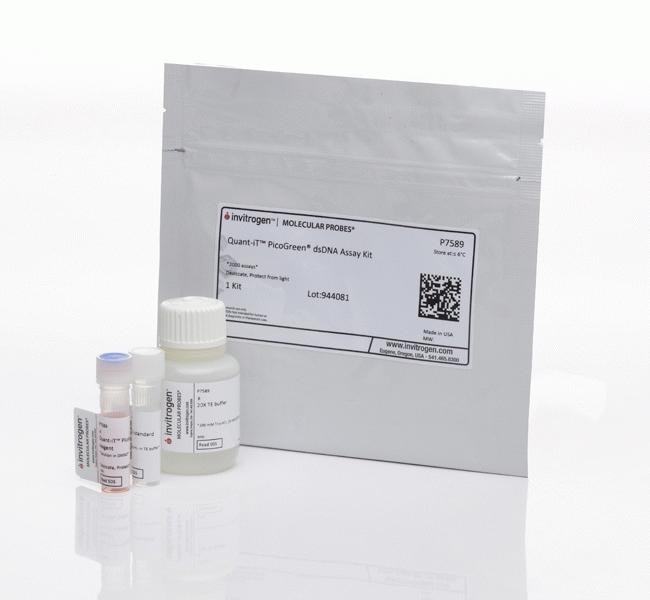Search Thermo Fisher Scientific

Certificates
SDS
Citations & References (355)
Invitrogen™
Quant-iT™ PicoGreen™ dsDNA Assay Kits and dsDNA Reagents
Selectively detect dsDNA from a wide variety of sources, and even in presence of ssDNA, RNA, and free nucleotides, with the Quant-iT PicoGreen dsDNA Assay Kit and PicoGreen dsDNA Reagent.
 Promotion
PromotionPromo code:P5780456
Gene Expression Promo
From RNA Isolation kits, reverse transcriptases to analysis of your gene with qPCR - upto 35% on all Gene Expression workflow productsLearn More
| Catalog Number | Quantity | Product Type | Packaging Type |
|---|---|---|---|
P7589 | 1 mL kit | dsDNA Assay Kit | 1 x 1 mL Bottle |
P11496 | 10 x 100 μL kit | dsDNA Assay Kit | 10 x 100 μL Tubes |
P7581 | 1 mL | dsDNA Reagent | 1 x 1 mL Bottle |
P11495 | 10 x 100 μL | dsDNA Reagent | 10 x 100 μL Tubes |
Catalog number P7589
Price (USD)
667.65
Online Exclusive
700.00Save 32.35 (5%)
Each
In stock
Quantity:
1 mL kit
Product Type:
dsDNA Assay Kit
Packaging Type:
1 x 1 mL Bottle
Price (USD)
667.65
Online Exclusive
700.00Save 32.35 (5%)
Each
Achieve precise and accurate dsDNA concentration measurements over a broad dynamic range with the Quant-iT Picogreen dsDNA Assay kits and dsDNA reagents. Picogreen assays are compatible with most microplate readers and fluorometers.
Rapidly detect as little as 0.25 pg/uL of dsDNA, even in the presence of ssDNA, RNA, and free nucleotides, using the PicoGreen dsDNA quantitation assay and reagent. The assay is linear over three orders of magnitude and has little sequence dependence, allowing you to accurately measure DNA from many sources, including genomic DNA, viral DNA, miniprep DNA, or PCR amplification products.
PicoGreen dsDNA quantitation reagents are
• Significantly more sensitive than UV absorbance readings, saving precious sample amounts
• Specific for dsDNA in the presence of RNA
• Easy to use—just add the dye working solution to the sample, incubate five minutes, and read
• Suitable for use in 96- and 384-well plate formats
• Compatible with most fluorescence-based microplate readers and fluorometers
• Picogreen aproximate fluorescence absorption/emission maxima is 502/523 nm, bound to dsDNA
Applications
The PicoGreen dsDNA quantitation reagent and kits are ideal for PCR-based assays, microarray samples, DNA damage assays, enzyme activity assays, genomic DNA quantitation, measuring dsDNA in complex mixtures, and viral DNA quantitation.
PicoGreen dsDNA quantitation reagents are
• Significantly more sensitive than UV absorbance readings, saving precious sample amounts
• Specific for dsDNA in the presence of RNA
• Easy to use—just add the dye working solution to the sample, incubate five minutes, and read
• Suitable for use in 96- and 384-well plate formats
• Compatible with most fluorescence-based microplate readers and fluorometers
• Picogreen aproximate fluorescence absorption/emission maxima is 502/523 nm, bound to dsDNA
Applications
The PicoGreen dsDNA quantitation reagent and kits are ideal for PCR-based assays, microarray samples, DNA damage assays, enzyme activity assays, genomic DNA quantitation, measuring dsDNA in complex mixtures, and viral DNA quantitation.
For Research Use Only. Not for use in diagnostic procedures.
Specifications
Excitation/Emission500/525
For Use With (Equipment)Microplate Reader
No. of Reactions200 Assays (2 mL assay volume)
Packaging Type1 x 1 mL Bottle
Product LinePICOGREEN, Quant-iT
Product TypedsDNA Assay Kit
Quantitation Range50 pg to 2 μg
Quantity1 mL kit
Shipping ConditionRoom Temperature
Detection MethodFluorescence
Unit SizeEach
Have questions about this product? Ask our AI assisted search.
How does the accuracy and sensitivity of the Qubit quantitation assays using the Qubit fluorometer compare to a microplate reader?
Can I use the Quant-iT and Qubit Kits with other fluorometers?
Can I make my own assay for the Qubit Fluorometer?
Can the Qubit kits give an indication of sample quality in nucleic acid samples?
What is the difference between the Quant-iT PicoGreen DNA, Quant-iT DNA, and Qubit DNA assays?
Show more FAQs for this product
This is an AI-powered search and may not always get things right. You can help us make it better with a thumbs up or down on individual answers or by selecting the “Give feedback" button. Your search history and customer login information may be retained by Thermo Fisher and processed in accordance with our
Privacy Notice.
Frequently asked questions (FAQs)
Figures

Figure 2 - dsDNA specificity

Figure 1 - Quantitation using the PicoGreen Reagent
Customers who viewed this item also viewed
Documents & Downloads
Certificates
Search by lot number or partial lot number
Lot #Certificate TypeDateCatalog Number(s)
3223921Certificate of AnalysisJun 18, 2025P7589
3148355Certificate of AnalysisJun 01, 2025P11496
3148355Certificate of AnalysisJun 01, 2025P11496
3148276Certificate of AnalysisMay 18, 2025P7589
3144317Certificate of AnalysisMay 14, 2025P7589
5 results displayed, search above for a specific certificate
Safety Data Sheets
SDS
Scientific Resources
Product Information
Citations & References (355)
Search citations by name, author, journal title or abstract text
Citations & References
Abstract
Journal:
PubMed ID:16517648
Mapping of multidrug resistance gene 1 and multidrug resistance-associated protein isoform 1 to 5 mRNA expression along the human intestinal tract.
Journal:Drug metabolism and disposition: the biological fate of chemicals
PubMed ID:15523049
Rapid quantification of DNA samples extracted from buccal scrapes prior to DNA profiling.
Journal:Biotechniques
PubMed ID:9232218
Exo-proofreading, a versatile SNP scoring technology.
Journal:Genome Res
PubMed ID:12695330
We report the validation of a new assay for typing single nucleotide polymorphisms (SNPs) that takes advantage of the 3'-to-5' exonuclease proofreading activity of many DNA polymerases. The assay uses one or more primers labeled on the 3' nucleotide base, and can be implemented in a variety of formats including
Simultaneous extraction from bacterioplankton of total RNA and DNA suitable for quantitative structure and function analyses.
Journal:Appl Environ Microbiol
PubMed ID:11872453
The aim of this study was to develop a protocol for the simultaneous extraction from bacterioplankton of RNA and DNA suitable for quantitative molecular analysis. By using a combined mechanical and chemical extraction method, the highest RNA and DNA yield was obtained with sodium lauryl sarcosinate-phenol or DivoLab-phenol as the
355 total citations
